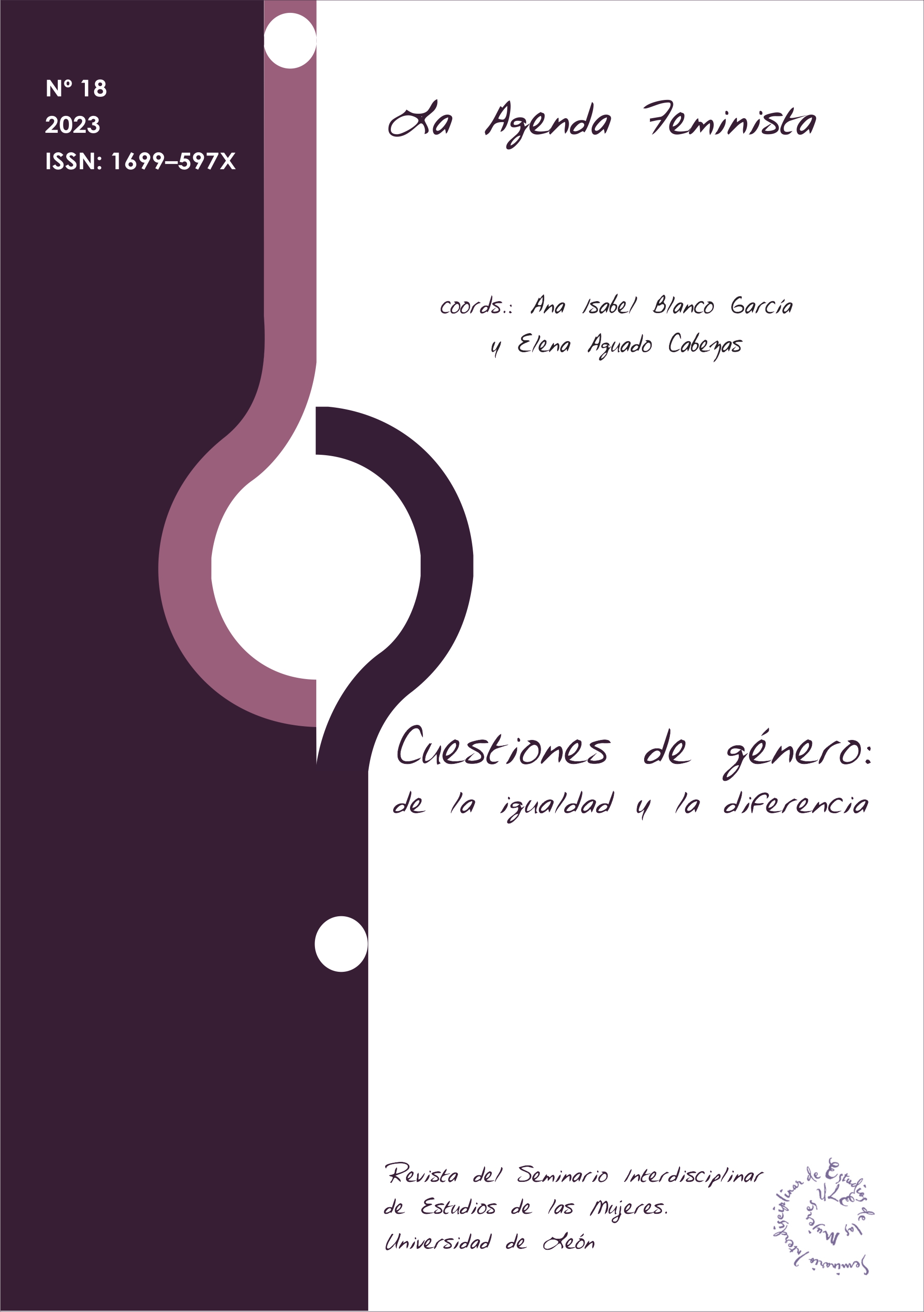Análisis del empoderamiento femenino con perspectiva multimodal de la antagonista Lady Eboshi en la película La princesa Mononoke (1997)
DOI:
https://doi.org/10.18002/cg.i18.7533Parole chiave:
empoderamiento femenino, poder desde dentro, poder sobre, multimodalidad, cine de animación japonés, Hayao Miyazaki, La princesa MononokeAbstract
El presente artículo ofrece un análisis del empoderamiento femenino con perspectiva multimodal de la antagonista Lady Eboshi en la película La princesa Mononoke (1997), dirigida por Hayao Miyazaki. El principal objetivo de investigación es analizar las muestras individuales de empoderamiento femenino encontradas en su poder desde dentro y poder sobre. Los datos de este artículo fueron tomados a partir de tres escenas esenciales por medio de una metodología principalmente cualitativa-descriptiva, aunque también se aportan datos cuantitativos recogidos en una rúbrica de elaboración propia que incluye diferentes indicadores tales como el sentido del yo, la confianza y la autoestima. Finalmente, los resultados obtenidos mostrarán si Eboshi se trata realmente de un claro ejemplo de empoderamiento femenino.
Downloads
Métricas alternativas
Riferimenti bibliografici
Bachrach, Peter y Baratz, Morton S. (1970): Power and Poverty: Theory and Practice. Nueva York: Oxford University Press.
Baldry, Anthony y Thibault, Paul J. (2006): Multimodal Transcription and Text Analysis: A multimedia toolkit and coursebook with associated on-line course. Londres: Equinox.
Bateman, John A. (2017): “Critical discourse analysis and film”. En: John Flowerdew y John E. Richardson (eds.): The Routledge Handbook of Critical Discourse Studies. Londres y Nueva York: Routledge, pp. 612-625.
Batliwala, Srilatha (1993): Empowerment of Women in South Asia: Concepts and Practices. Nueva Dehli: Asian-South Pacific Bureau of Adult Education.
Bendazzi, Giannalberto (2003): Cartoons. 110 años de cine de animación. Madrid: Ocho y Medio.
Béteille, Andre (1999): “Empowerment”. En: Economic and Political Weekly, vol 34, nº. 10-11, pp. 589-597.
Bisnath, Savitri y Elson, Diane (1999): “Women’s Empowerment Revisited”. Background Paper for Progress of the World’s Women 2000: a UNIFEM Report. Nueva York: UNIFEM.
Campoy Martínez, Alba (2020): Integrating Imperatives and Feminism through Princess Mononoke (1997) in the English as a Foreign or Second Language Classroom (Tesis de maestría). Alicante: Universidad de Alicante.
Cavallaro, Dani (2006): The Animé Art of Hayao Miyazaki. Jefferson: McFarland & Company, Inc.
Chamberlain, Prudence (2017): The Feminist Fourth Wave: Affective Temporality. Londres: Palgrave Macmillan.
Cornwall, Andrea y Edwards, Jenny (2014): “Introduction: Negotiating Empowerment”. En: Andrea Cornwall y Jenny Edwards (eds.): Feminisms, Empowerment and Development: Changing Women’s Lives. Londres y Nueva York: Zed Books, pp. 1-31.
Dahl, Robert A. (1957): “The Concept of Power”. En: Behavioral Science, vol. 2, pp. 201-215.
Dahl, Robert A. (1961): Who Governs? Democracy and Power in an American City. New Haven: Yale University Press.
Fairclough, Norman (2010): Critical Discourse Analysis: The Critical Study of Language. 2ª ed. Londres: Routledge.
Flowerdew, John (2013): Discourse in English Language Education. Londres y Nueva York: Routledge.
Jewitt, Carey; Bezemer, Jeff y O’Halloran, Kay (2016): Introducing Multimodality. Londres: Routledge.
Jung, Carl G. (1970): Arquetipos e inconsciente colectivo. Barcelona: Paidós.
Kabeer, Naila (1994): Reversed Realities: Gender Hierarchies in Development Thought. Londres: Verso Publications.
Kabeer, Naila (1999): The conditions and consequences of choice: reflections on the measurement of women’s empowerment (Nº. 108). Suiza: United Nations Research Institute for Social Development (UNRISD).
Karlekar, Malavika (2015): “Introduction”. En: Omita Goyal (ed.): Interrogating Women’s Leadership & Empowerment. Londres: SAGE Publications, pp. xi-xxii.
Kowalska, Dominika (2018): The Fourth Wave of American Feminism: Ideas, Activism, Social Media. Tesis de maestría. Varsovia: Universidad de Varsovia.
Kress, Gunther (2010): Multimodality: A Social Semiotic Approach to Contemporary Communication. Londres y Nueva York: Routledge.
Kress, Gunther y van Leeuwen, Theo (1996): Reading Images: The Grammar of Visual Design. Nueva York: Routledge.
Kress, Gunther y van Leeuwen, Theo (2001): Multimodal Discourse: The Modes and Media of Contemporary Communication. Londres: Arnold.
Lenburg, Jeff (2012): Hayao Miyazaki: Japan’s Premier Anime Storyteller. Nueva York: Chelsea House.
Lukes, Steven (2021): Power. A Radical View. 3ª ed. Londres: Macmillan International Higher Education.
Lyons, Agnieszka (2016): “Multimodality”. En: Zhu Hua (ed.): Research Methods in Intercultural Communication: A practical guide. Wiley-Blackwell, pp. 268-280.
Machin, David y Mayr, Andrea (2012): How To Do Critical Discourse Analysis: A Multimodal Introduction. Londres: SAGE Publications.
Marañón, Iria (2018): Educar en el feminismo. Barcelona: Plataforma Actual.
McCarthy, Helen (2018): “Teenage Wildlife: Princess Mononoke and Hayao Miyazaki’s Theory of the Feminine”. En: Rayna Denison (ed.): Princess Mononoke: Understanding Studio Ghibli’s Monster Princess. Londres: Bloomsbury Academic, pp. 97-114.
Miyazaki, Hayao (1997): La princesa Mononoke [Película]. Tokio: Studio Ghibli.
Napier, Susan J. (2005): Anime from Akira to Howl’s Moving Castle. Experiencing Contemporary Japanese Animation. Londres: Palgrave Macmillan.
Napier, Susan J. (2018): Miyazakiworld. A Life in Art. New Haven y Londres: Yale University Press.
O’Halloran, Kay (2011): “Multimodal Discourse Analysis”. En: Ken Hyland y Brian Paltridge (eds.): Companion to Discourse. Londres y Nueva York: Continuum, pp. 120-137.
O’Toole, Michael (1994): The Language of Displayed Art. Londres: Leicester University Press.
Odell, Colin y Le Blanc, Michelle (2015): Studio Ghibli. The Films of Hayao Miyazaki and Isao Takahata. 2ª ed. Croydon: Kamera Books.
Polsby, Nelson W. (1963): Community Power and Political Theory. New Haven: Yale University Press.
Rogers, Carl R. (1959): “A Theory of Therapy, Personality, and Interpersonal Relationships: As Developed in the Client-Centered Framework”. En: Sigmund Koch (ed.): Psychology: A Study of a Science. Formulations of the Person and the Social Context. Nueva York: McGraw Hill, pp. 184-256.
Rogers, Carl R. (1972): Psicoterapia centrada en el cliente. Barcelona: Paidós.
Rowlands, Jo (1997): Questioning Empowerment: Working with Women in Honduras. Oxford: Oxfam Publishing.
Rowlands, Jo (1998): “A Word of the Times, but What Does it Mean? Empowerment in the Discourse and Practice of Development”. En: Haleh Afshar (ed.): Women and Empowerment: Illustrations from the Third World. Londres: Macmillan, pp. 11-34.
Sen, Gita (1997): “Empowerment as an Approach to Poverty”. En: Poverty and human development, pp. 175-194.
Tamaki, Saitō (2006): Beautiful Fighting Girl. Minneapolis: University of Minnesota Press.
Unsworth, Len (2011): Multimodal Semiotic. Functional Analysis in Contexts of Education. Londres: Bloomsbury Academic.
Unsworth, Len; Thomas, Angela; Simpson, Alyson y Asha, Jennifer (2005): Children’s literature and computer-based teaching. Berkshire: Open University Press.
Von Feigenblatt, Otto (2007): Understanding Japanese Animation. Florida: Guild of Independent Scholars.
Williams, Suzanne; Seed, Janet y Mwau, Adelina (1995): The Oxfam Gender Training Manual. Londres: Oxfam.
Wolfinger, Raymond E. (1971): “Nondecisions and the Study of Local Politics”. En: American Political Science Review, vol. 65, nº. 4, pp. 1063-1080.
Pubblicato
Come citare
Fascicolo
Sezione
Licenza
Copyright (c) 2023 Alba Campoy Martínez

Questo lavoro è fornito con la licenza Creative Commons Attribuzione - Non commerciale - Condividi allo stesso modo 4.0 Internazionale.
L@s autores/as que publican en esta revista están de acuerdo con los siguientes términos:
1. L@s autores/as ceden de forma no exclusiva los derechos de explotación (reproducción, distribución, comunicación pública, transformación) a la Universidad de León, por lo que pueden establecer, por separado, acuerdos adicionales para la distribución no exclusiva de la versión de la obra publicada en la revista (por ejemplo, alojarlo en un repositorio institucional o publicarlo en un libro), con un reconocimiento de su publicación inicial en esta revista.
2. Este trabajo se encuentra bajo la Creative Commons Attribution-NonCommercial-ShareAlike 4.0 International License. Puede consultarse desde aquí la versión informativa y el texto legal de la licencia.
3. Se permite y se anima a l@s autores/as a difundir electrónicamente las versiones pre-print (versión antes de ser evaluada) y/o post-print (versión evaluada y aceptada para su publicación) de sus obras antes de su publicación, ya que favorece su circulación y difusión más temprana y con ello un posible aumento en su citación y alcance entre la comunidad académica.
Cuestiones de Género utiliza exclusivamente la licencia Atribución-NoComercial-CompartirIgual 4.0 Internacional (CC BY- NC-SA 4.0).
Bajo los siguientes términos:
- Atribución: Usted debe dar crédito de manera adecuada , brindar un enlace a la licencia, e indicar si se han realizado cambios . Puede hacerlo en cualquier forma razonable, pero no de forma tal que sugiera que usted o su uso tienen el apoyo de la licenciante.
- No Comercial: Usted no puede hacer uso del material con propósitos comerciales .
- Compartir Igual: Si remezcla, transforma o crea a partir del material, debe distribuir su contribución bajo la la misma licencia del original. cualquier uso permitido por la licencia.
No hay restricciones adicionales — No puede aplicar términos legales ni medidas tecnológicas que restrinjan legalmente a otras a hacer
L@s autores/as pueden consultar los derechos de copyright y las condiciones de autoarchivo en el directorio Dulcinea.










